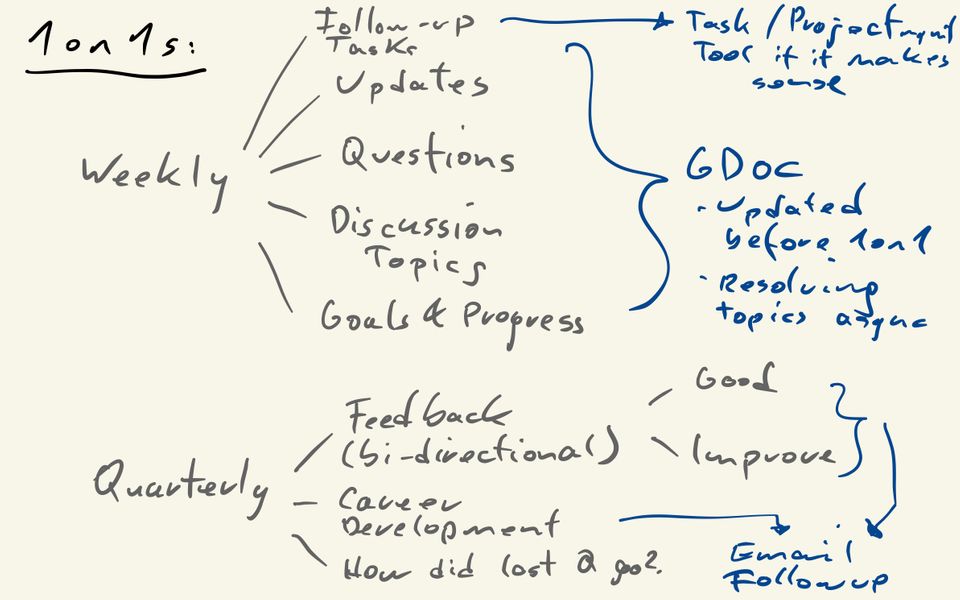Looking back now, it’s easy to admit that we had no clue how to manage and run a company when we started Codeship at the end of 2010. Yet, somehow, my co-founders Flo, Manny, and I, agreed that doing regular 1on1s would be a good thing. I don’t remember why, but it served us well.
Why 1on1s
Doing recurring 1on1s with your direct reports is your single most effective management tool. It doesn’t matter whether you are managing an intern, senior executive, an engineer, or a salesperson. Talking regularly and having an open communication channel will help your employees and their teams perform at their highest levels. 1on1s improve employee happiness and help surface issues or problems in your team early on. If done well,1on1s will steer your team in the right direction, build a cohesive culture, and ensure that your direct reports can grow and achieve their career goals.
How I do 1on1s
Putting a recurring 30-minute slot on your calendar is the easy part. Over the years, I have tried various approaches on how to structure my 1on1s. For some time, they were vastly unstructured — “Just chatting”. I also had a time when I went through the agenda like a robot. I completely controlled and dominated them. Then I put it all on my counterpart, the employee - “It’s your 1on1. Let me know how you want to use it.” After painfully learning how to lead and manage, I settled on a more nuanced approach. After all, it depends on the employee, their personality style (consider leveraging HBDI or a similar framework), their job, mood, current life situation, whether they are succeeding or struggling at work, and many more things.
Nevertheless, I found a basic structure to run all the 1on1s that works well for me.
Weekly 1on1s
I found that talking to my direct reports weekly works best for me. It provides a good cadence. I compare it with a multi-day hike, a road trip, or sailing for days from island to island. You wouldn’t enjoy your trip if you constantly stared at your map. Regularly checking it gives you plenty of opportunities to course correct in case you get off track. Doing weekly 1on1s gives you ~40 checkpoints throughout the year.
My weekly 1on1s usually focus on day-to-day operations. Providing guidance and enabling my direct report to succeed. Conversations with junior employees are more focused on specific initiatives or tasks (e.g., doing a code review together or reviewing a marketing newsletter). With more senior team members, I spend the majority of the time on strategic topics. I allocate between 30 and 60 minutes per 1on1. There’s no magic number. It’s different for every employee, and also changes over time. For example, I spend more time with new hires in the beginning, and less time once we get into a good rhythm. That might change again should they get more responsibility, a more significant role, or need more help to succeed.
For every 1on1, I set up a dedicated Google Doc and share it with my direct report. It’s a living journal with an entry for every 1on1. It enables us to come to the meeting prepared, resolve some topics asynchronously, and keep track of follow-up tasks. I use a simple structure that is filled out by both of us every single week.
Updates
Everything that doesn’t require any discussion or action but is worthwhile sharing. This part gets consumed asynchronously. E.g., “I made an offer to candidate xyz, she accepted, and starts on January 6.”
Questions
Any questions that don’t require any discussion and you can resolve asynchronously. E.g., “Did our budget for the next fiscal year get approved by the board?”
Leveraging comments and action items in the Google Doc helps to resolve those questions asynchronously.
Discussion Topics
This section is the core part of the 1on1. It covers everything that needs a live, synchronous discussion during the 1on1. E.g., “There’s an opportunity to partner with vendor xyz. Here are the pros and cons of building a product integration now. Let’s discuss and make a decision during the 1on1.”
Follow-up Tasks
I sometimes use a dedicated section to cover any action items that come out of the discussion. You might also leverage whatever project or task management tool your company is using. E.g., “Mo to feedback keynote storyline by December 20.”
If you use a Google Doc to track those follow-up tasks, you should mark them as done asynchronously. If needed, provide “Updates” in your next 1on1 (tip: use the Google Docs action item functionality).
Template
Some of your employees might have specific goals tied to a variable compensation (MBOs, sales compensation plan), while others might not. Regardless of the compensation piece, you should have objectives defined to measure the performance of your employee. Maybe you use OKRs or some other goal-setting framework. In the absence of that, you might have agreed with your employees on a list of skills they need to acquire or improve.
I put these goals right at the top of the Google Doc and update this section only on a monthly or quarterly basis (or whenever the KPIs change). That makes the goals top of mind every week, and you can tie back the updates and discussion topics to them.
Here is a simple template of the Google Doc that you can copy and use for yourself.
Quarterly 1on1s
Additionally, to the weekly 1on1s, I schedule “special” quarterly check-ins. Those quarterly conversations are the polar opposite of the weekly meetings. No operational and tactical topics get discussed in those 1on1s. The quarterly 1on1s are all about giving each other feedback (it’s bi-directional), improving the working relationship, talking about career development, and stepping back and reflecting on how the last three months went for your employee.
It doesn’t mean you shouldn’t provide feedback weekly. You absolutely should. But it’s powerful to force yourself to have a dedicated conversation in a regular cadence that’s solely focused on ensuring your employees grow, can achieve their career goals, and are genuinely fulfilled by their work.
I usually schedule those conversations for 60 minutes and follow a simple plan.
How did the last quarter go?
This question provides an opportunity to reflect, do a retrospective, and share each other’s POV about the last three months. It naturally flows into the next section.
Bi-directional feedback
After the retrospective, I share feedback with the employee grouped into two buckets, “Great” and “Improve”. Ideally, you also get feedback from your employee. The manager-employee dynamic might work against you, but you should ask for feedback and be open to it. Asking specific questions (“Did I support you sufficiently with your last project?”) vs. stating the generic “How can I do better” question will make it easier for the employee to provide feedback.
If there’s an area an employee needs to work on (because there’s a performance issue), you should define clear goals and put those into your “Weekly 1on1” Google Doc. It might make sense to use a 360 review mechanism to get feedback for your employee from multiple people in your organization.
Career Development
Some of your employees might want to advance, get more responsibility, while others might not, or not at this time in their life. You should regularly have a conversation about this to ensure you know your employee’s career goals. If those are clear, I usually spend this part of the quarterly 1on1 talking about those goals and how my direct report is advancing towards those objectives.
I don’t use a Google Doc for the quarterly conversations. The frequency is too low for that in my experience. What I found helpful is sending out the feedback (ideally both sides) after the chat. It can be a super short email. It helps to reinforce your points and provide clarity to the employee. It’s also powerful to be able to go back and see the feedback from previous quarters. You could also add that feedback to your 1on1 journal if you prefer that.
Conclusion
1on1s aren’t rocket science. Yet, it still makes sense to put a basic structure in place. Once you start growing your company or team, this has the additional benefit of creating a coherent approach to running 1on1s across the whole organization. Guiding first-time managers set them up for success. Quarterly 1on1s are a powerful tool to create a consistent feedback culture across all teams. Whatever I do might not work for you. There’s no right or wrong. If you think there’s a better or different way to run your 1on1s, just do it (and please let me know because I’m curious how to do them better).
Finally, if you are an employee and work for a manager who doesn’t use any structure for the 1on1s, consider putting this template in place yourself. Managing up is as important as managing down.
1on1s - A Simple Frameworkhttps://t.co/zlRRNepFt5
— Moritz Plassnig (@moritzplassnig) September 27, 2020

